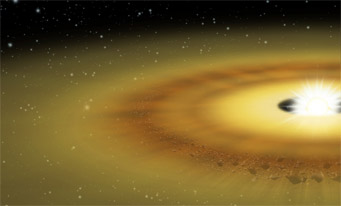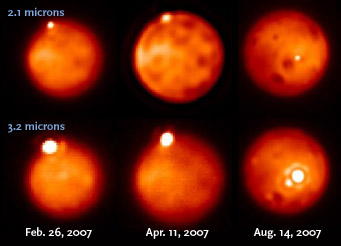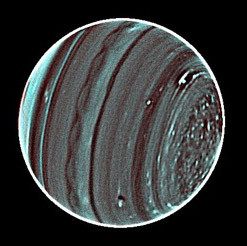Planetary scientists had plenty of new results to present this week at the 44th annual meeting of the American Astronomical Society's Division for Planetary Sciences. Here are some of the highlights.

An artist's portrayal of the very flat protoplanetary disk around Beta Pictoris, a close neighbor of the Sun that's only 60 light-years away.
Motohide Tamura & others
Planetary Crepes
A UCLA duo reported October 15th that more than 85% of planetary systems are "flatter than pancakes." Julia Fang and Jean-Luc Margot created computer mockups of a diverse range of exoplanet systems in which the planets take less than 200 days to orbit their suns. Then they determined what these systems would look like to Kepler and compared the results to actual Kepler detections.
The team found that, in 85% of all cases, the planets' orbital inclinations were less than 3°, meaning that if you looked at the systems from the side, their thicknesses would be something between a crepe and a pancake (as determined by Margot's cooking trials). The flatness is similar to our own solar system and suggests that most planetary systems evolve undisturbed by major shakeups. Click to read Fang and Margot's research paper.

When observed at near-infrared wavelengths with the world's best ground-based telescopes, Io shows frequent volcanic eruptions on its surface.
Franck Marchis
Earth's Eyes on Io
Researchers at NASA's SETI Institute have captured 40 snapshots of volcanic eruptions on Io, and all from the comfort of home. Earth-based telescopes have taken over the task of monitoring the Jovian satellite — the last spacecraft to fly by Io was New Horizons in 2007, and no future visits are planned. Equipped with adaptive optics, 8- to 10-meter telescopes can resolve details as small as 100 km (60 miles). Ground-based scopes have watched several fire fountains erupt over the years, but oddly enough, none since 2010: for the past two years, all has been quiescent on the Ionian front. Click to learn more about the new ground-based observations of Io.

As captured with the Keck II telescope's adaptive-optics system, this highly processed view of Uranus shows extensive banding and many small methane-ice clouds in its upper atmosphere. The planet's north pole is on teh right.
L. Sromovsky & others
Best-Ever Pix of Uranus
When Voyager 2 flew by Uranus in 1986, the planet offered little to see: just a deep, clear atmosphere of greenish blue "air." Since then Uranus has grown clouds and weather. In July astronomers at Keck Observatory on Mauna Kea obtain the most detail-rich images of Uranus ever taken, using adaptive optics and a variety of other techniques.
Uranus’s hydrogen-and-helium atmosphere contains substantial methane, which can freeze out and form white clouds. Some of the resulting weather systems "stay at fixed latitudes and undergo large variations in activity," says Larry Sromovsky (University of Wisconsin). "Others are seen to drift toward the planet's equator while undergoing great changes in size and shape." This complexity is puzzling because strength of sunlight at Uranus is only 1⁄900 that at Earth, and (unlike Neptune) the planet has no detectable energy coming from its interior. For details see this press release.

Frames from a computer simulation show how debris from a giant impact with early Earth evolved into a encircling ring of superheated matter — derived from both objects — that later collected and cooled to form the Moon.
Matija Ćuk & Sarah Stewart
A New Way to Make the Moon
How did the Moon come to be? For nearly 30 years, planetary scientists have generally agreed that it's a consequence of something big (roughly Mars-size) having struck the very young Earth. Other hypotheses have been proposed, going back to the late 1800s, but only this "big splat" comes close to satisfying a wide array of physical and geochemical constraints — and one of the most stringent is the high angular momentum of the Earth-Moon system. To get it, it's been thought, the impactor must have dealt Earth a glancing blow.
But a nagging geochemical problem, dynamicists admit, is that a glancing blow leaves the Moon with too much impactor and too little proto-Earth. But new simulations by Matija Ćuk and Sarah Stewart (Harvard University) sidestep this dilemma by having the impactor make more of a direct hit on an Earth that was rotating in just 2 or 3 hours — whirling so rapidly that it was close to flying apart on its own. Find out more in a press release describing Ćuk and Stewart's work, which appears in full in the October 17th edition of Science Express.
 7
7
Comments
James Cleland
October 21, 2012 at 4:45 am
It surprises me that this convention was held in Reno Nevada. As astronomers we need to be speaking with our feet and money about light pollution.Las vegas was named one of the most light polluted cities by IDA.We should not be supporting this kind of behavior with the money from conventions.
You must be logged in to post a comment.
Bruce
October 22, 2012 at 6:10 am
Well, ok, but how do you get a hyper-rotating proto-earth to have formed prior to the big splat? This idea exchanges an unlikely collision angle for a perhaps more unlikely prior condition, it would seem. Was proto-earth bombarded with a huge preponderance of rotationally accelerating impact events? Or, was some other Great Accelerator cause at work here?
You must be logged in to post a comment.
Rod
October 23, 2012 at 9:43 pm
Bruce, the Cuk and Stewart press release indicates the proto-Earth is not rapidly rotating before the giant impact. I don't think the model has a rapidly spinning proto-earth in the beginning. The original rotation rate of the proto-Earth is not disclosed in the model before the giant impact. Given random accretion and impacts, the proto-Earth before the giant impact could have a day = 365 days or extremely slow. This model does not define the pre-giant impact rotation period of proto-Earth or if limits apply here that will not work without special conditions being invoked to achieve the 2-3 hour rotation period needed. Also the proto-Earth would have to increase in mass within certain limits too to avoid having a completely different Earth-Moon system and angular momentum we see today.
You must be logged in to post a comment.
Bruce
October 24, 2012 at 11:55 am
Um, I think you must have missed something Rod, which is unusual. Kelly Beatty, a reliable source I should think, says above: “new simulations by Matija Ćuk and Sarah Stewart (Harvard University) sidestep this dilemma by having the impactor make more of a direct hit on an Earth that was rotating in just 2 or 3 hours — whirling so rapidly that it was close to flying apart on its own.” Then from the report Kelly links to I quote two paragraphs: “Therefore, the original giant impact model has a major problem: it can match the mass of the Moon and the rotation rates of the Earth and Moon, but not the chemistry of the Moon. Today, tides between the Earth and Moon slow Earth’s rotation and push the Moon’s orbit further away, but the total angular momentum (see glossary) is conserved. Going back in time, the early Earth had a day of only 5 hours when the Moon formed. With a post-impact spin period of about 5 hours, a giant impact could not loft enough Earth material into orbit to make the Moon match the chemistry of the Earth.
Ćuk and Stewart show that if Earth’s initial angular momentum were higher, corresponding to an Earth day between 2 and 3 hours, a giant impact can eject enough Earth material into orbit to make a Moon with the same isotopic fingerprint. A day of only 2 hours is near the point when the Earth would begin to fly apart from rotational forces. When the Earth is spinning near this rotation limit, it is much easier to launch Earth material into orbit during a giant impact.”
You must be logged in to post a comment.
Rod
October 24, 2012 at 8:04 pm
Bruce, good catch in the Cuk and Stewart report. However note, there are other competing models too and the Canup model was also published during the same time that does not feature a rapidly rotating proto-earth, ref - http://www.livescience.com/24081-moon-formation-earth-giant-impact.html. My observation - the Canup model must have a slower rotating proto-earth before the giant impact compared to the Cuk and Stewart model reported which features a fast spinning, proto-earth before the giant impact to help make the Moon. How accretion could form such a fast spinning proto-earth appears dubious in view of Mars present rotation period and Venus very slow rotation. We must also remember that in the early solar system, impacts arriving at different angles and velocities, all random impacts in the early solar system, some impacts could add angular momentum to the proto-earth while other impacts can subtract angular momentum and slow the rotation down as well as flip the proto-earth axis all around. Things to watch out for in the angular momentum changing impact models invoked to explain the origin of our Moon and Earth's present 24 hour day. We also need to pay attention to the growth of the proto-earth mass and proto-moon after the giant impact event making the Moon in the computer models. Wrong mass accretion amounts and rates here could alter the output of the computer models used to simulate the giant impact event with Theia making our Moon.
You must be logged in to post a comment.
Bruce
October 25, 2012 at 4:28 pm
Ok, Rod now we’re on the same page I think. Your post fleshes out the same lines of thought I had in questioning the likelihood of an extremely rapidly rotating proto-earth back in the second post of this thread. I agree that random chance seems an unlikely cause for hyper rotation, and my guess is that a statistical, random model of pro-earth accretion would yield this extreme rotation very rarely. I don’t want to imply that I don’t like this idea though. As Matija Ćuk and Sarah Stewart (nice to see more female astronomers making there mark on the field) point out, this model does seem to fit the current observations better than the others. My take on this is that the arrangement of the Sun-Earth-Moon system seems increasingly hard to come by merely by accident. But if we don’t think this was an accident … (Job 42:2)
You must be logged in to post a comment.
Peter
October 29, 2012 at 8:53 pm
Interestingly enough, while collisions are more-or-less random in a protoplanetary disk, planets will tend to spin in the same direction as the disk rotates. I forget the reason why, but there is a slight impact imbalance in the direction the disk is orbiting the star…not an Intelligent Accelerator! Not sure if the effect is enough to generate the “extreme” rotation called for in the new model, but Theia is more likely than not to have hit Earth in such a way as to spin it up. I believe when Shoemaker-Levy 9 collided with Jupiter, it also added to Jupiter’s angular momentum.
You must be logged in to post a comment.
You must be logged in to post a comment.